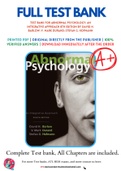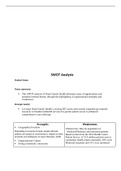PRINTED PDF | ORIGINAL DIRECTLY FROM THE PUBLISHER | 100%
VERIFIED ANSWERS | DOWNLOAD IMMEDIATELY AFTER THE ORDER
s t u v i a c o n t a c t + e x a m s s h o p @ g m a i l . c o mFor more Test banks, ATI, HESI exams, and more contact us here:
FULL TEST BANK
T e s t B a n k F o r A b n o r m a l P s y c h o l o g y : A n
I n t e g r a t i v e A p p r o a c h 8 t h E d i t i o n b y D a v i d H .
B a r l o w ; V . M a r k D u r a n d ; S t e f a n G . H o f m a n n
Complete Test bank, All Chapters are included. Page 1 1. Psychological abnormality is generally defined using “the four D's.” Fi rst, explain what the four Ds are and what they mean regarding psychological abnormality. Then provide an example of a time when each aspect of abnormality would not be considered abnormal. 2. Suppose a friend says to you, “I feel really lousy today, and I don't know why. You're taking abnormal psych—what do you think?” If, after a conversation, your friend feel s better about things, have you provided psychological therapy? Why or why not? Inc lude the essential features of therapy in your answer. 3. What is demonology? How does demonology stand in the way of a more complete understanding of the causes and treatment of psychological abnormality? 4. Discuss the contributions of three individuals to the treatment of abnormal psychology . Be sure to include when and where each lived. 5. Create a time line on which you place five major events in the history of abnorma lity. Briefly describe why each event is important to an understanding of abnormality . 6. Define and contrast the somatogenic and psychogenic perspectives regarding abnorm al psychological functioning, and provide at least one example of evidence supporting each perspective. 7. Assume that Benjamin Rush and Dorothea Dix suddenly appeared in the twenty-first century, about 50 years after the U.S. policy of deinstitutionalization began. What would they think about our treatment of the “mentally ill”? What suggestions might they make for changes in our policy of deinstitutionalization? 8. According to your text, deinstitutionalization has resulted, in part, in large number s of people with severe psychological disturbances either becoming homeless or ending up in jail or prison. Is deinstitutionalization an ethical and appropriate strategy for the treatment of mental illness that the United States should continue to follow? Back up your answer with specific examples. 9. Increasingly, people seeking treatment for mental health reasons are mem bers of managed care programs. How are managed care programs changing how psy chological services are provided? Discuss one advantage and one disadvantage of such programs. www.nursylab.com
www.nursylab.com Page 2 10. Clinical psychologists, psychiatrists, and clinical researchers are m ental health professionals that work in the area of psychological abnormality. Describe what ea ch does and how they differ from each other. 11. What are important differences between case studies and single-subject exper iments? Be sure to mention advantages and disadvantages of each. 12. Case studies can be used to help more than just the one being studied. Briefly describe three ways one could use information gathered from a case study besides helping the one being studied. 13. Describe three hypothetical correlations: positive correlations, negative corr elations, and unrelated correlations, and give an example for each. 14. A major shortcoming of a correlational study is that even when a correlation be tween two variables is statistically significant, one cannot infer causation. For example, a significant correlation exists between life stress and depression, yet one cannot say for sure that life stress causes depression. Given this major shortcoming, what are some specific reasons one might still wish to conduct a correlational study, as opposed to an experimental study (from which one might infer a cause-and-effect relationshi p)? 15. Assume that a researcher wishes to do research designed to pinpoint early-childhood events related to later development of eating disorders such as anorexia nervosa. Wha t type of investigation might the researcher use? What would be potential strengths and weaknesses of that type of investigation? Finally, are there any ethical conce rns the researcher ought to address? 16. Design an experiment to test the hypothesis that older women who take estrogen are l ess likely to develop Alzheimer's disease. Be sure to identify the control group, experimental group, independent variable, and dependent variable. 17. A researcher wishes to use experimentation to study the effect of stress on the development of abnormal behaviors. Describe how the researcher might conduct that study, using either natural or analogue experiments. www.nursylab.com
www.nursylab.com Page 3 Answer Key
1. There are said to be four “Ds” of psychological abnormality. The first is “deviance,” which describes abnormal behavior, thoughts, and emotions that differ markedly from society's ideas about proper functioning. An example of deviance that would not be considered abnormal is a person who sleeps outside when camping. While sleeping outdoors is not the norm in our society, we make exception for this behavior under this specific circumstance. The second is “distress.” When an individual feels distress over symptom manifestation, we often consider this a marker of abnormality. An example of when distress would not be considered abnormal would be a situation in which a parent experiences distress because his or her child is serving in the military in a war zone. The feelings of distress inherent in a daughter or son serving abroad would not be enough to label someone as abnormal in functioning. The third element in psychological abnormality is “dysfunction.” Abnormal behavior tends to be considered dysfunctional when it interrupts the ability to function in daily living. An example of when dysfunction would not be considered abnormal would be if someone voluntarily engaged in a hunger strike out of protest. Often these individuals are considered heroic rather than dysfunctional. The final element is “danger,” which is usually classified as an individual being a danger or threat to him- or herself or others. An example of when dangerousness would not be considered abnormal could be during times of military service in combat. Individuals in combat are sometimes called on to harm others, and in acts considered heroic, some soldiers sacrifice their own lives for the safety of their group. 2. According to my text, I have not provided psychological therapy. Clinical theorist Jerome Frank stated that all therapy has three essential features. One is a su fferer who seeks relief from the healer. The second feature of true therapy is that it must be administered by a trained, socially accepted healer who has expertise in wha t the individual struggles with. The third essential element of therapy is that there should be a series of contacts with the sufferer to produce changes. In this example the second and third criteria have not been satisfied. As such, psychological therapy has not take n place.
3. Demonology is the view that psychological dysfunction was caused by Satan's influence. In Europe during the Middle Ages, members of the clergy had great power, and their religious beliefs and explanations dominated education and culture. Due to its influence, the Church controlled how psychological phenomena were interpreted, and alternative scientific explanations were dismissed. 4. Answers may include any of the following, or other figures discussed in the text: Hippocrates: 460–377 B.C. Greece. Referred to as the father of modern medicine, Hippocrates contributed the belief that illnesses had natural causes, and he saw abnormal behavior as arising from physical problems. www.nursylab.com
www.nursylab.com





